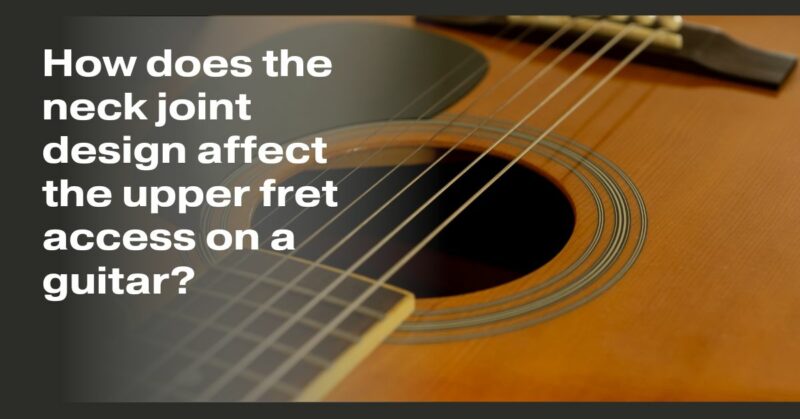When it comes to electric and acoustic guitars, one often-overlooked but crucial aspect of playability is the neck joint design. The neck joint serves as the connection between the neck and the body of the guitar, and its design can significantly affect the player’s ability to access the upper frets. In this article, we will explore how different neck joint designs impact upper fret access and the overall playability of a guitar.
Understanding Neck Joint Designs:
Before delving into how neck joint designs affect upper fret access, it’s essential to familiarize yourself with some common neck joint designs:
- Bolt-On Neck: In this design, the neck is bolted onto the guitar body. It’s a popular choice for electric guitars and some acoustic models. Bolt-on necks are known for their ease of maintenance and potential for customization.
- Set Neck: A set neck is glued into a carved pocket in the body. This design is common in many Gibson-style electric guitars and some high-end acoustic models. Set necks are known for their sustain and resonance.
- Neck-Through-Body: In this design, the neck extends through the entire length of the body, with the wings of the body attached on either side. Neck-through-body guitars often offer excellent sustain and upper fret access.
How Neck Joint Design Affects Upper Fret Access:
- Bolt-On Neck: Bolt-on necks typically provide easy access to the upper frets. The joint is usually located around the 15th or 16th fret, allowing players to comfortably reach the highest frets without obstruction. This design is favored by guitarists who require excellent upper fret access, such as those who play shredding solos or intricate lead lines.
- Set Neck: Guitars with set necks often have a joint around the 14th fret, which can slightly limit upper fret access compared to bolt-on necks. However, many players find the difference negligible, and set necks offer excellent sustain and tone.
- Neck-Through-Body: Neck-through-body guitars provide the most unrestricted upper fret access. With no neck joint to obstruct the player’s hand, these guitars allow for effortless navigation of the entire fretboard. This design is a favorite among virtuoso guitarists who demand the utmost in playability.
Considerations for Upper Fret Access:
- Playing Style: The style of music you play and your playing technique can influence your preference for neck joint design. If you frequently venture into the upper frets for solos or intricate melodies, a neck-through-body design might be the ideal choice. However, for rhythm players or those who don’t frequently use the upper frets, a bolt-on or set neck may suffice.
- Comfort: Upper fret access not only affects playability but also the comfort of playing higher on the neck. Neck-through-body guitars provide the most comfortable access, making them suitable for guitarists who prefer to explore the upper register.
- Tone and Sustain: Keep in mind that different neck joint designs can also influence the guitar’s tone and sustain. Set necks, for example, are known for their resonance and sustain, which may be a consideration if you prioritize these qualities over upper fret access.
Conclusion: Finding the Perfect Balance
The neck joint design is a crucial factor in determining how easily you can access the upper frets on a guitar. While each design offers its unique advantages and considerations, there is no one-size-fits-all answer. The best neck joint for you depends on your playing style, comfort preferences, and tonal priorities. Ultimately, finding the perfect balance between upper fret access and other desirable guitar qualities is essential for creating a guitar that suits your musical needs and allows you to express yourself fully as a guitarist.


